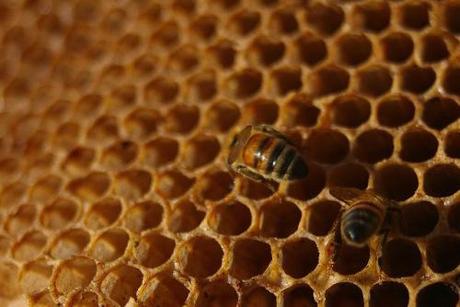A toxin found in bee venom may be a new weapon against HIV infection

by botheredbybees
From my column at Communities @ Washington Times
WASHINGTON DC, March14, 2013 –A paper published in the current issue of Antiviral Therapy suggests that bee venom may be the next line of defense against HIV, the virus that causes AIDS. While research is in its preliminary stages, there may be reasons to be optimistic.
According to specialists at Washington University School of Medicine in St. Louis, melittin, a toxin found in bee venom, can be used to destroy HIV cells while not harming surrounding cells. Differing from current HIV prevention and treatment, researchers at Washington University devised a novel way to deliver a toxin that attacks HIV cells directly, and not the virus’ ability to replicate.
HIV has proven difficult to combat because of its small size when compared to other cells, its ability to adapt and develop resistance to treatment, and the fact that HIV cells are covered with a double-layered membrane that forms a protective envelope around the cells which makes them difficult to eliminate. Melittin works by forming “pore-like attack complexes” that rupture and strip the protective envelope from HIV cells.
To deliver the toxin without harming other cells, scientists used melittin-loaded nanoparticles equipped with special bumpers that bounce off regularly sized cells. Conversely, the much smaller HIV cells fit between the bumpers and come into contact with the melittin, which goes to work destroying the HIV cells’ outer envelope.
This delivery system was originally developed as an artificial blood product to deliver oxygen, but was not very successful. However, since it circulates in the blood safely, Hood and his colleagues adapted it to deliver melittin instead of oxygen.
Currently, most retroviral drugs used to treat HIV target the virus’ ability to replicate. This research is seen as groundbreaking in that it attacks the virus’ structure. By attacking a physical property of HIV, according to lead researcher Dr. Joshua L. Hood, MD, PhD, it is unlikely that the virus will develop resistance because there is no way for the virus to adapt to losing its crucial protective outer layer.
Researchers foresee two uses for melittin in preventing and treating HIV: as a vaginal gel to prevent infection and as intravenous therapy for existing HIV infection. The gel would be especially helpful in preventing new infections in places where HIV is widespread, according to Dr. Hood. In treating existing infection, this therapy could be particularly useful in drug-resistant cases.
The results of the study go beyond combating the spread of HIV. Samuel A. Wickline, MD, the study’s senior author, has also shown that this type of therapy may have the same effect on tumor cells. Moreover, it has been suggested that this melittin-loaded nanoparticle therapy could also be effective against a range of viruses, including Hepatitis B and C, since these viruses rely on a similar protective envelope.
Most specialists and experts agree, however, that it is too soon to tell. Research is still in its preliminary stages, and has only been tested in a lab and not on a living organism. Much more research and testing will need to be done before it can even be tested on humans. However, it does show a new way of tackling the virus and thinking outside the box–which may be just what is needed to eradicate HIV and AIDS.
Read more of my articles
